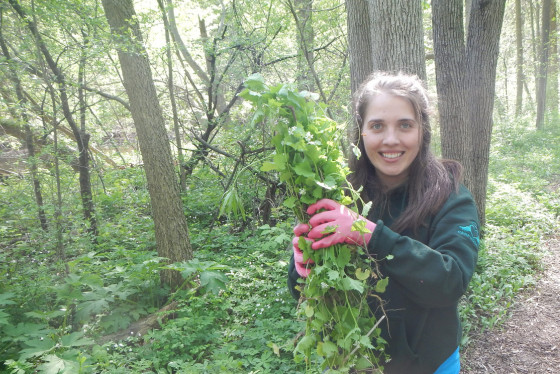Contact: DNR Office of Communications
DNRPress@wisconsin.gov
Help Prevent The Spread Of Invasive Species
 Help protect native plants and animals by taking simple precautions to avoid spreading invasives in our woods, waters and lands.
Photo credit: Wisconsin DNR
Help protect native plants and animals by taking simple precautions to avoid spreading invasives in our woods, waters and lands.
Photo credit: Wisconsin DNR
MADISON, Wis. – The Wisconsin Department of Natural Resources (DNR) asks the public to take simple precautions to avoid spreading invasive plants and animals in June, which is Invasive Species Action Month, and all year long.
Invasive species are nonnative plants, animals and diseases that cause great ecological, environmental or economic harm. Some have already been found in Wisconsin, while others pose a large risk of surviving and causing problems if they are introduced and established here.
The state’s invasive species rule makes it illegal to possess, transport, transfer or introduce certain invasive species in Wisconsin without a permit. The regulations designate which species are Restricted or Prohibited based on factors including the degree of harm they may cause to people, the native ecology or the economy.
How You Can Help
To prevent the establishment and spread of invasives, the DNR encourages reporting invasive species and offers the following tips.
While hiking and camping:
- Clean mud and dirt off shoes.
- Remove seeds and burs from clothing.
- Stay on designated trails, roads and other developed areas. Avoid areas infested with invasive species; “When in doubt, stay out!”
- Follow Wisconsin’s firewood rules to avoid moving harmful invasive pests and pathogens like the emerald ash borer, spongy moth and oak wilt disease.
While fishing and boating:
- Clean all recreational equipment and gear after every use to protect Wisconsin’s waters from fish diseases and aquatic invasives like quagga and zebra mussels, Eurasian water-milfoil, New Zealand mudsnails and Asian clams.
- Inspect gear for dirt, mud, seeds and other debris, removing as much as possible before and after launching.
- Drain all water from gear and compartments before leaving your fishing location.
- Dry gear for five or more days between uses to help destroy invasive organisms.
- Never move live fish away from any waterbody.
While gardening and doing leisure activities:
- Add beauty and variety to your yard with native plants to benefit pollinators, birds and other wildlife. Or add traditional gardening plants that are noninvasive. The DNR’s Plant Native Plants webpage is a great resource to get started.
- Learn how to identify and remove potential problem plants from your property, including Bishop’s goutweed, burning bush, creeping bellflower, Dame’s rocket, Amur honeysuckle, water hyacinth, water lettuce and European frog-bit.
- When using non-native crayfish for crayfish boils, use frozen (not live) crayfish or rusty crayfish harvested from Wisconsin waterbodies.
While volunteering and teaching:
- Connect with Wisconsin Cooperative Invasive Species Management Areas (CISMAs), local or regional organizations in Wisconsin that bring together landowners and land managers to coordinate action and share expertise and resources to manage invasive species.
- Sign up for emails about local State Natural Area volunteer workdays to clear brush, remove invasives and help maintain our state’s natural landscapes.
- Sign up for updates and information from the DNR about invasive species and Wisconsin’s regulations.
- Participate in Invasive Species Awareness Day on June 22 at a Wisconsin State Park property. Find Invasive Species Awareness Day volunteer opportunities on the State Parks Volunteer webpage.
Visit the DNR’s website to learn more ways to prevent invasive species from establishing.

